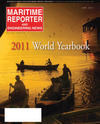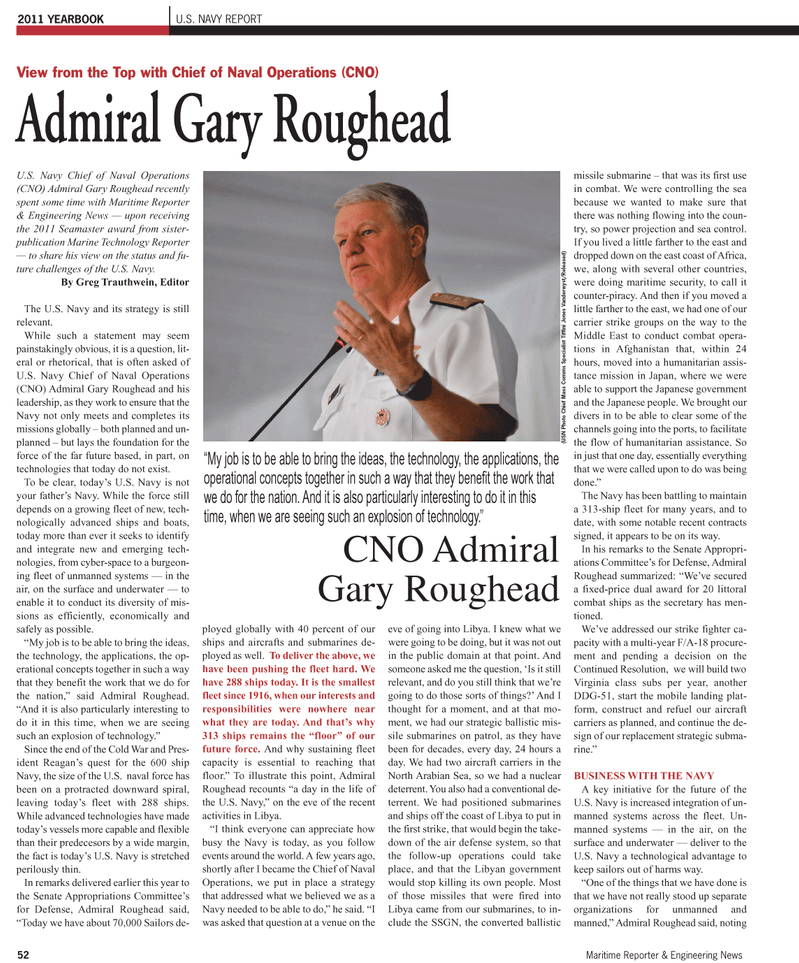
Page 56: of Maritime Reporter Magazine (June 2011)
Feature: Annual World Yearbook
Read this page in Pdf, Flash or Html5 edition of June 2011 Maritime Reporter Magazine
52Maritime Reporter & Engineering News U.S. Navy Chief of Naval Operations (CNO) Admiral Gary Roughead recently spent some time with Maritime Reporter& Engineering News ? upon receiving the 2011 Seamaster award from sister- publication Marine Technology Reporter ? to share his view on the status and fu- ture challenges of the U.S. Navy. By Greg Trauthwein, Editor The U.S. Navy and its strategy is still relevant. While such a statement may seempainstakingly obvious, it is a question, lit- eral or rhetorical, that is often asked of U.S. Navy Chief of Naval Operations (CNO) Admiral Gary Roughead and his leadership, as they work to ensure that the Navy not only meets and completes its missions globally ? both planned and un-planned ? but lays the foundation for the force of the far future based, in part, on technologies that today do not exist. To be clear, todays U.S. Navy is not your fathers Navy. While the force still depends on a growing fleet of new, tech- nologically advanced ships and boats, today more than ever it seeks to identify and integrate new and emerging tech- nologies, from cyber-space to a burgeon- ing fleet of unmanned systems ? in theair, on the surface and underwater ? to enable it to conduct its diversity of mis- sions as efficiently, economically and safely as possible.My job is to be able to bring the ideas,the technology, the applications, the op- erational concepts together in such a way that they benefit the work that we do for the nation,? said Admiral Roughead. And it is also particularly interesting to do it in this time, when we are seeingsuch an explosion of technology.? Since the end of the Cold War and Pres- ident Reagans quest for the 600 ship Navy, the size of the U.S. naval force has been on a protracted downward spiral, leaving todays fleet with 288 ships. While advanced technologies have made todays vessels more capable and flexible than their predecesors by a wide margin, the fact is todays U.S. Navy is stretched perilously thin.In remarks delivered earlier this year to the Senate Appropriations Committees for Defense, Admiral Roughead said, Today we have about 70,000 Sailors de- ployed globally with 40 percent of our ships and aircrafts and submarines de-ployed as well. To deliver the above, we have been pushing the fleet hard. We have 288 ships today. It is the smallest fleet since 1916, when our interests and responsibilities were nowhere near what they are today. And thats why 313 ships remains the floor? of our future force. And why sustaining fleetcapacity is essential to reaching thatfloor.? To illustrate this point, Admiral Roughead recounts a day in the life ofthe U.S. Navy,? on the eve of the recent activities in Libya. I think everyone can appreciate how busy the Navy is today, as you follow events around the world. A few years ago, shortly after I became the Chief of Naval Operations, we put in place a strategy that addressed what we believed we as a Navy needed to be able to do,? he said. I was asked that question at a venue on the eve of going into Libya. I knew what we were going to be doing, but it was not out in the public domain at that point. And someone asked me the question, Is it still relevant, and do you still think that were going to do those sorts of things? And I thought for a moment, and at that mo-ment, we had our strategic ballistic mis- sile submarines on patrol, as they have been for decades, every day, 24 hours a day. We had two aircraft carriers in the North Arabian Sea, so we had a nuclear deterrent. You also had a conventional de- terrent. We had positioned submarines and ships off the coast of Libya to put in the first strike, that would begin the take- down of the air defense system, so that the follow-up operations could take place, and that the Libyan government would stop killing its own people. Most of those missiles that were fired into Libya came from our submarines, to in-clude the SSGN, the converted ballistic missile submarine ? that was its first use in combat. We were controlling the sea because we wanted to make sure that there was nothing flowing into the coun- try, so power projection and sea control. If you lived a little farther to the east and dropped down on the east coast of Africa, we, along with several other countries, were doing maritime security, to call it counter-piracy. And then if you moved a little farther to the east, we had one of our carrier strike groups on the way to the Middle East to conduct combat opera- tions in Afghanistan that, within 24 hours, moved into a humanitarian assis- tance mission in Japan, where we wereable to support the Japanese government and the Japanese people. We brought our divers in to be able to clear some of the channels going into the ports, to facilitate the flow of humanitarian assistance. So in just that one day, essentially everything that we were called upon to do was being done.? The Navy has been battling to maintain a 313-ship fleet for many years, and to date, with some notable recent contractssigned, it appears to be on its way. In his remarks to the Senate Appropri- ations Committees for Defense, Admiral Roughead summarized: Weve secured a fixed-price dual award for 20 littoral combat ships as the secretary has men-tioned. Weve addressed our strike fighter ca- pacity with a multi-year F/A-18 procure-ment and pending a decision on theContinued Resolution, we will build two Virginia class subs per year, another DDG-51, start the mobile landing plat-form, construct and refuel our aircraftcarriers as planned, and continue the de-sign of our replacement strategic subma- rine.? BUSINESS WITH THE NAVY A key initiative for the future of the U.S. Navy is increased integration of un- manned systems across the fleet. Un-manned systems ? in the air, on the surface and underwater ? deliver to the U.S. Navy a technological advantage to keep sailors out of harms way. One of the things that we have done is that we have not really stood up separate organizations for unmanned and manned,? Admiral Roughead said, noting View from the Top with Chief of Naval Operations (CNO) Admiral Gary Roughead (USN Photo Chief Mass Comms Specialist Tiffini Jones Vanderwyst/Released) 2011 YEARBOOKU.S. NAVY REPORT My job is to be able to bring the ideas, the technology, the applications, the operational concepts together in such a way that they benefit the work that we do for the nation. And it is also particularly interesting to do it in this time, when we are seeing such an explosion of technology.? CNO Admiral Gary Roughead

 55
55

 57
57
